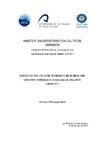Please use this identifier to cite or link to this item:
https://accedacris.ulpgc.es/jspui/handle/10553/74923
| Title: | Effect of the culture temperature during the greater amberjack (Seriola dumerili, Risso 1810) grow-out | Authors: | Merlo, Vincenzo Giuseppe | Director: | Robaina Robaina, Lidia Esther Izquierdo López, María Soledad |
UNESCO Clasification: | 251092 Acuicultura marina | Keywords: | Seriola dumerili Culture temperature |
Issue Date: | 2014 | Project: | AQUATRANS, proyecto de cooperación transfronteriza (FEDER), Programa POCTEFEX (Programa de Cooperación Transfronteriza España-Fronteras Exteriores) | Abstract: | The greater amberjack (Seriola dumerili), as a high-value fast growing species, has been
considered an excellent candidate for marine aquaculture. Bottlenecks for this species
culture include the improvement of the performance during the grow-out period and
the definition of optimum temperature ranges in the Mediterranean regions. Thus, the
aim of this study was to better understand the greater amberjack adaptation and
response to different culture temperature conditions. For that, groups of fish (mean
initial weight of 203 ± 20.67 g) were randomly distributed in 10 m3
tanks and reared at
two seawater temperatures 23 °C and 26 °C, each tested in triplicates of 160 fish.
Tanks were supplied with natural seawater in open and close circulated system,
respectively for the lower and the higher temperature. Fish were daily hand fed with
commercial feeds until apparent satiation 2 times per day during 105 days. Culture
conditions, fish behaviour and feed intake were studied and samples of fish and tissues
were taken at initial, intermediate and at the end of the trial for biochemical, fatty
acids, colour and quality parameters.
At the end of the trial high survival good feeding behavior were obtained in all tanks
regardless the temperature tested. However, growth was higher at 23 °C (400.60 ±
35.05 g final weight gain, and an SGR of 1.04 ± 0.05 % day
-1
) than at 26 °C (269.52 ±
22.51 g final weight gain and an SGR of 0.80 ± 0.04 % day-1
). Feed utilization
parameters, such as PER was higher at 23 °C (1.44 ± 0.06) than at 26 °C (1.06 ± 0.10)
and FCR, also better at 23 °C (1.30 ± 0.21) than at 26 °C (1.94 ± 0.25), whose difference
was only significant during the first 43 days. Lipid content of whole fish and lipid
content and protein of muscle were also higher at 23 °C than at 26 °C, with an increase
in the relative content of polyunsaturated at 23 °C. The skin colour was more tending
towards red (redness) at 23 °C, but more saturated at 26 °C. On the contrary, flesh
colour was more reddish and saturated at 26 °C. El pez limón (Seriola dumerili), especie de alto valor comercial y rápido crecimiento, ha sido considerado como un excelente candidato para la acuicultura marina. Los cuellos de botella para el cultivo de esta especie incluyen, la mejora del rendimiento durante el período de engorde y la definición de rangos de temperatura óptima en las regiones Mediterráneas. Por lo tanto, el objetivo de este estudio fue comprender mejor la adaptación del pez limón y la respuesta a diferentes condiciones de temperatura de cultivo. Para ello, grupos de peces (peso medio inicial de 203 ± 20,67 g) se distribuyeron aleatoriamente en tanques de 10 m3 y cultivaron en agua de mar a dos temperaturas, 23 °C y 26 °C, cada una testada por triplicado de 160 peces. Los tanques fueron suministrados con agua de mar natural en un sistema a circuito abierto y cerrado, respectivamente para la baja y alta temperatura. Los peces fueron alimentados a mano diariamente con alimentos comerciales hasta saciedad aparente, 2 veces al día durante 105 días. Fueron estudiados las condiciones de cultivo, el comportamiento de los peces y la ingesta de alimento. Se tomaron muestras de peces y de tejidos en la parte inicial, intermedia y final de la prueba, para el análisis bioquímico, los ácidos grasos, el color y los parámetros de calidad. Al final del experimento fueron obtenidos una alta supervivencia y buen comportamiento alimenticio en todos los tanques, independientemente de la temperatura probada. Sin embargo, el crecimiento fue más alto a 23 °C (400,60 ± 35,05 g ganancia de peso final, y un SGR de 1,04 ± 0,05 % día-1 ) que a 26 °C (269,52 ± 22,51 g ganancia de peso final y un SGR de 0,80 ± 0,04 % día-1 ). Los parámetros de utilización del alimento, tales como el PER fue más alto a 23 °C (1,44 ± 0,06) que a 26 °C (1,06 ± 0,10) y el FCR, también mejor a 23 °C (1,30 ± 0,21) que a 26 °C (1,94 ± 0,25), cuya diferencia fue significativa sólo en los primeros 43 días. El contenido lípidico de pez entero y el contenido lípidico y proteico del músculo también fueron más altos a 23 °C que a 26 °C, con un aumento en el contenido relativo de poliinsaturados a 23 °C. El color de la piel fue más tendiente hacia el rojo (redness) a 23 °C, pero más saturado a 26 °C. Al contrario, el color del filete fue más rojizo y saturado a 26 °C. |
Department: | Departamento de Biología | Faculty: | Facultad de Ciencias del Mar | Degree: | Máster Universitario en Cultivos Marinos | URI: | https://accedacris.ulpgc.es/handle/10553/74923 |
| Appears in Collections: | Trabajo final de máster Restringido ULPGC |
En el caso de que no encuentre el documento puede ser debido a que el centro o las/os autoras/es no autorizan su publicación. Si tiene verdadero interés en el contenido del mismo, puede dirigirse al director/a o directores/as del trabajo cuyos datos encontrará más arriba.
Show full item recordPage view(s)
66
checked on Feb 24, 2024
Download(s)
21
checked on Feb 24, 2024
Google ScholarTM
Check
Share
Export metadata
Items in accedaCRIS are protected by copyright, with all rights reserved, unless otherwise indicated.
